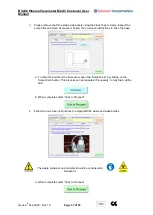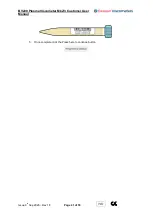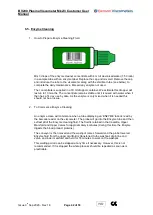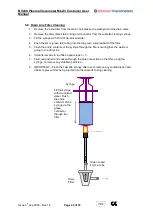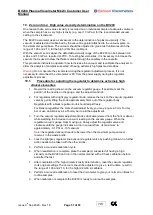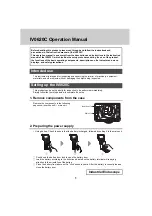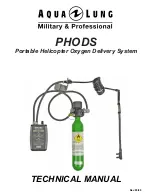
BV200 Plasma Viscometer Mk2/3 Customer User
Manual
Issue 9
th
Sep 2020 - Rev 1.8
Page 51 of 53
10. Zero run time: High value viscosity determination on the BV200
One reason that a zero-value viscosity is recorded on an individual sample of adequate volume is
when the sample has a very high viscosity (e.g. over 10 mPa.s) for the recommended vacuum
setting on the viscometer.
The BV200 viscometer uses a set vacuum in the determination of a plasma viscosity. This
vacuum is adjusted and maintained by the vacuum regulator attached to the vacuum pump on
the viscometer pump base. The vacuum should be adjusted to give a test runtime result in the
range of 1.90 and 2.10. for the high (2.0mPa.s) calibrant.
With the vacuum set as above the detectable viscosity range of the BV200 can be between 0.6
mPa.s and 10 mPa.s. reported at 25°C. To test higher viscosities, it is necessary to increase the
vacuum that is used to draw the thicker sample through the capillary in the cassette.
This procedure instructs an operator how to increase the vacuum and recalibrate the analyser to
allow the analysis of samples suspected of having extremely high plasma viscosities.
Warning:
Do not operate the viscometer during the regulator adjustment process. It is not
necessary to disconnect the viscometer or PC from the power supply during the regulator
adjustment process.
10.1.
Procedure for adjusting the regulator to determine extremely high
clinical viscosities
Record the reading shown on the vacuum regulator gauge. If possible, mark the
1.
position of the needle on the gauge, and the adjustment knob.
For regulators with a light grey regulator knob, release the lock on the vacuum regulator
2.
valve by gently lifting the knob approximately 3mm out of the regulator body.
Regulators with a black regulator knob should adjust freely.
For Benson regulators the stem should adjust freely, you may require a 3mm Tommy
bar or use an Allen key as a Tommy bar to aid the adjustment.
Turn the vacuum regulator adjustment knobs clockwise (viewed from the front or above)
3.
while watching the increase in vacuum reading on the vacuum gauge. When the
regulator vacuum gauge stops moving up, slowly adjust the regulator valve anti
clockwise until the gauge indicates a drop in vacuum from its maximum to
approximately -0.1 PSI or -10% vacuum
Note:
the regulated vacuum needs to be lower than the maximum pump vacuum
reservoir in the waste bottle.
Lock the light grey regulator knob vacuum regulator valve by pushing it down, no further
4.
action needs to be taken with the other knobs.
Perform a manual recalibration cycle.
5.
When recalibration is complete, place the sample(s) suspected of having a high
6.
viscosity on the BV200 and run in the normal manner with a Check calibration before
and after the test.
After completion of the high clinical viscosity determination, reset the vacuum regulator
7.
to its original settings The vacuum should be adjusted to give a test runtime result in
the range of 1.90 and 2.10. for the high (2.0mPa.s) calibrant.
Perform a manual recalibration to reset the Viscometer to give your normal run times for
8.
routine samples.
When calibration is complete the BV200 is ready to run routine samples.
9.

